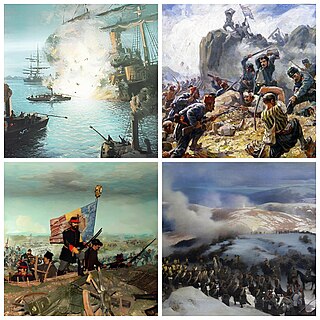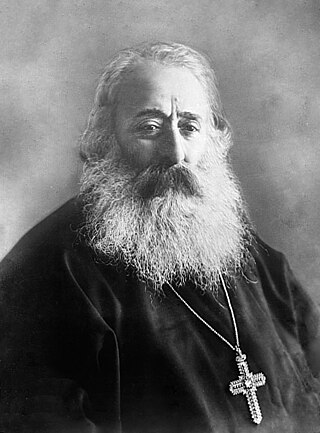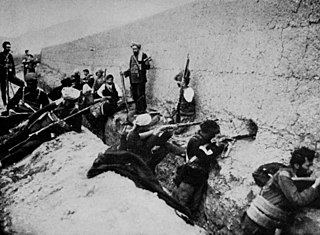
The Ottoman Empire, historically and colloquially known as the Turkish Empire, was an imperial realm that spanned much of Southeast Europe, West Asia, and North Africa from the 14th to early 20th centuries; it also controlled parts of southeastern Central Europe between the early 16th and early 18th centuries.

The Armenian genocide was the systematic destruction of the Armenian people and identity in the Ottoman Empire during World War I. Spearheaded by the ruling Committee of Union and Progress (CUP), it was implemented primarily through the mass murder of around one million Armenians during death marches to the Syrian Desert and the forced Islamization of others, primarily women and children.

The Russo-Turkish War was a conflict between the Ottoman Empire and a coalition led by the Russian Empire which included Bulgaria, Romania, Serbia, and Montenegro. Fought in the Balkans and in the Caucasus, it originated in emerging 19th-century Balkan nationalism. Additional factors included the Russian goals of recovering territorial losses endured during the Crimean War of 1853–1856, re-establishing itself in the Black Sea and supporting the political movement attempting to free Balkan nations from the Ottoman Empire.

The Ottoman Empire was founded c. 1299 by Osman I as a small beylik in northwestern Asia Minor just south of the Byzantine capital Constantinople. In 1326, the Ottomans captured nearby Bursa, cutting off Asia Minor from Byzantine control. The Ottomans first crossed into Europe in 1352, establishing a permanent settlement at Çimpe Castle on the Dardanelles in 1354 and moving their capital to Edirne (Adrianople) in 1369. At the same time, the numerous small Turkic states in Asia Minor were assimilated into the budding Ottoman sultanate through conquest or declarations of allegiance.

In the late 18th century, the Ottoman Empire faced threats on numerous frontiers from multiple industrialised European powers. In response, the empire initiated a period of internal reform, attempting to bring itself into competition with the expanding West. The period of these reforms is known as the Tanzimat, and led to the end of the Old Regime period. Despite the Ottoman empire's precarious international position, the central state was significantly strengthened. The process of reforming and modernization in the empire began with the declaration of the Nizam-I Cedid during the reign of Sultan Selim III and was punctuated by several reform decrees, such as the Hatt-ı Şerif of Gülhane in 1839 and the Hatt-ı Hümayun in 1856. Over the course of the 19th century, the Ottoman state became increasingly powerful and rationalized, exercising a greater degree of influence over its population than in any previous era.

The history of the Jews in Turkey covers the 2400 years that Jews have lived in what is now Turkey.

The dissolution of the Ottoman Empire (1908–1922) was a period of history of the Ottoman Empire beginning with the Young Turk Revolution and ultimately ending with the empire's dissolution and the founding of the modern state of Turkey.

The American Robert College of Istanbul, often abbreviated as Robert or RC, is a highly selective, independent, co-educational, private high school in Turkey. The school is situated in a 265-acre (107 ha) wooded campus on the European side of Istanbul in the Beşiktaş district, with the historic Arnavutköy neighborhood to the east and the upscale Ulus neighborhood to the west. Founded in 1863, Robert College is the oldest continuously operating American school outside the United States.

Mkrtich Khrimian was an Armenian Apostolic Church leader, educator, and publisher who served as Catholicos of All Armenians from 1893 to 1907. During this period he was known as Mkrtich I of Van.

Education in Turkey is governed by a national system which was established in accordance with the Atatürk's Reforms. It is a state-supervised system designed to produce a skillful professional class for the social and economic institutes of the nation.
Armenians in Turkey, one of the indigenous peoples of Turkey, have an estimated population of 50,000 to 70,000, down from a population of over 2 million Armenians between the years 1914 and 1921. Today, the overwhelming majority of Turkish Armenians are concentrated in Istanbul. They support their own newspapers, churches and schools, and the majority belong to the Armenian Apostolic faith and a minority of Armenians in Turkey belong to the Armenian Catholic Church or to the Armenian Evangelical Church. They are not considered part of the Armenian Diaspora, since they have been living in their historical homeland for more than four thousand years.

The defense of Van was the armed resistance of the Armenian population of Van against the Ottoman Empire's attempts to massacre the Ottoman Armenian population of the Van Vilayet in the 1915 Armenian genocide. Several contemporaneous observers and later historians have concluded that the Ottoman government deliberately instigated an armed Armenian resistance in the city and then used this insurgency as the main pretext to justify beginning the deportation and slaughter of Armenians throughout the empire. Witness reports agree that the Armenian posture at Van was defensive and an act of resistance to massacre. The self-defense action is frequently cited in Armenian genocide denial literature; it has become "the alpha and omega of the plea of 'military necessity'" to excuse the genocide and portray the persecution of Armenians as justified.

The Armenian national awakening resembles that of other non-Turkish ethnic groups during the rise of nationalism under the Ottoman Empire in development of ideas of nationalism, salvation and independence in Armenia, as the Ottoman Empire tried to cover the social needs by creating the Tanzimat era, the development of Ottomanism and First Constitutional Era. However, the coexistence of the communities under Ottomanism proved to be a dysfunctional solution as did the Second Constitutional Era which also ignited the dissolution of the Ottoman Empire.
The Armenian national movement included social, cultural, but primarily political and military movements that reached their height during World War I and the following years, initially seeking improved status for Armenians in the Ottoman and Russian Empires but eventually attempting to achieve an Armenian state.

The Ottoman Armenian population mostly belonged to either the Armenian Apostolic Church or the Armenian Catholic Church. They were part of the Armenian millet until the Tanzimat reforms in the nineteenth century equalized all Ottoman citizens before the law. Armenians were a minority in the Empire. They played what would later be seen as a crucial role in Ottoman industry and commerce, and Armenian communities existed in almost every major city of the empire. Despite this, Armenians were heavily persecuted by the Ottoman authorities especially from the latter half of the 19th century, culminating in the Armenian Genocide.

Armenian nationalism in the modern period has its roots in the romantic nationalism of Mikayel Chamchian (1738–1823) and generally defined as the creation of a free, independent and united Armenia formulated as the Armenian Cause. Armenian national awakening developed in the 1880s in the context of the general rise of nationalism under the Ottoman Empire. The Russian Armenia followed with significant causes. The Armenian Apostolic Church has been a great defender of Armenian nationalism, with leaders like Khrimian Hayrik who devoted his life to the peasantry. The establishment of modern Armenia (1991) and Armenian social fabric becoming more complex gradually decrease the political influence of Hye Dat and shifted towards a modern Armenian nationalism modeled as a liberal nationalism.

The following outline is provided as an overview of and topical guide to Turkey:

Ottoman Greeks were ethnic Greeks who lived in the Ottoman Empire (1299–1922), much of which is in modern Turkey. Ottoman Greeks were Greek Orthodox Christians who belonged to the Rum Millet. They were concentrated in eastern Thrace, and western, central, and northeastern Anatolia. There were also sizeable Greek communities elsewhere in the Ottoman Balkans, Ottoman Armenia, and the Ottoman Caucasus, including in what, between 1878 and 1917, made up the Russian Caucasus province of Kars Oblast, in which Pontic Greeks, northeastern Anatolian Greeks, and Caucasus Greeks who had collaborated with the Russian Imperial Army in the Russo-Turkish War of 1828–1829 were settled in over 70 villages, as part of official Russian policy to re-populate with Orthodox Christians an area that was traditionally made up of Ottoman Muslims and Armenians.

The Armenian Philanthropic Society of Baku or the Martasiragan was a philanthropic organization built and operated by the Armenian community of Baku. It was established in 1863–1864 and became the first philanthropic organization in the Caucasus. In 1870 the Armenian Philanthropic Society established the first library and publication house in Baku. The library was the largest in the Caucasus.
Turkish textbooks have faced criticism for their negative depiction of Greeks and Armenians, lack of depiction or explicit denial of Ottoman-era massacres and genocides, denial of the existence of the Kurdish people, as well as understating and condoning Ottoman-era slavery. According to a study by Abdulkerim Şen, human rights education in Turkey subscribes to the 'escapist model'; Şen explains that Turkish textbooks either deliberately avoid human rights issues, struggles, campaigns, and activists altogether, or window-dress human rights issues by presenting de-contextualised narratives. Şen further states that the curriculum fails in respect of critically examining on discrepancies about claims made in Turkish textbooks vis-à-vis realities of human rights; and has scope to improve the curriculum encouraging learners to explore transformative powers of Human Rights Education.














